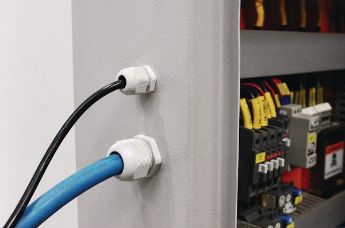
Cable glands are used in electrical installations to connect systems and provide mechanical protection to cables by securing them in place while preventing strain on the connections. This helps to avoid damage to the cables from pulling, bending, or abrasion.
Key benefits:
Cable glands consist of three main parts: locknut, thread and fitting. The thread goes through a hole and is tightened with a locknut. There are fixed threads, swivel threads and variable angle threads available.

All HellermannTyton cable glands are waterproof and provide a tight seal around cables. Thus, they are commonly used in outdoor applications or harsh environments as waterproof cable glands ensure that cables remain protected from weather conditions, moisture and even saltwater.
Use cases for watertight cable glands are for example:
HellermannTyton offers plastic cable glands made from nylon. They find application in various industries and environments where a lightweight design and cost-effectiveness are priorities. Nylon is a popular material for cable gland connectors because it is durable, resistant to corrosion as well as various environmental conditions such as moisture, chemicals, and UV radiation, and provides great sealing properties. Since nylon is an insulating material, these plastic cable glands can provide additional electrical safety. Industrial cable glands come in various sizes to accommodate different cable diameters and can be used in both indoor and outdoor applications.

The technical drawing provides a cross-sectional view of a plastic cable gland. In order to specify the correct cable gland size to ensure proper fitting and sealing, the overall diameter at the top part (D), the height of the bottom part (H), the diameter of the bottom part (D2) and the height of the lower portion of the cable gland (H2) are essential.
HellermannTyton cable glands can be used in a wide range of industrial applications as they are available in two thread patterns: with swivel external threads and swivel flange.

Cable glands with fixed external threads may require more space for installation since the entire gland body rotates during tightening. If more flexibility and convenience during installation is needed, cable gland connectors with swivel external threads can be used. They feature external threads that can rotate or swivel independently of the gland body. The gland body remains stationary while only the external threads rotate during installation, making it easier to tighten the gland onto the mating surface without having to rotate the entire gland body.
Key benefits of industrial cable glands with swivel external threads:

Cable glands with swivel flange combine the features of swivel external threads with an additional flange component. The flange is a flat or slightly curved metal or plastic plate attached to the gland body. It provides a mounting surface for securely fastening the cable gland to a panel or enclosure.
During installation, the swivel flange allows the gland body to remain stationary while only the external threads rotate. This makes it easier to tighten the cable gland connector onto the mating surface without having to rotate the entire gland body. Once the external threads are tightened, the flange can be secured to the panel or enclosure using screws or other fasteners, providing a stable and secure mounting arrangement.
Cable gland and cable termination are two related but distinct concepts in the context of electrical and electronic systems. A cable connector gland is a mechanical component designed to secure and protect the end of a cable where it enters an enclosure, panel, or piece of equipment. Cable termination refers to the process of connecting the end of a cable to a device, terminal, or another cable in an electrical or electronic system.
Determining the size of cable gland you need depends on several factors, including the diameter of the cable you are using, the specifications of the equipment or enclosure you are installing it on, and any relevant industry standards or regulations. Consult the datasheet or technical specifications of the cable connector gland you plan to use. Cable glands are typically designed to accommodate a specific range of cable diameters, which should be listed in the product documentation.
There are several types of cable glands available, each designed to meet specific requirements and application needs. The most common type are threaded cable glands. They feature a threaded entry that allows them to be screwed into a matching threaded hole on an enclosure or panel. Threaded cable gland connectors provide a secure and reliable connection and are available in various materials such as plastic, brass, stainless steel, and aluminium.
Cable glands secure and protect the ends of electrical wires around entry points by incorporating a sealing element, a locknut and a compression fitting. The sealing is typically made of rubber and forms a tight seal around the cable to prevent ingress of moisture and dust. The locknut is screwed onto the body of the gland, securing it to the equipment. The compression fitting tightens around the cable and provides strain relief while ensuring a secure connection.
The most common Harmonised System (HS) code for plastic cable glands, including nylon, is 8547.20. However, it is recommended to confirm this with the latest version of the HS code directory or consult with a customs broker or trade specialist, as classifications can sometimes be updated or subject to specific national interpretations.